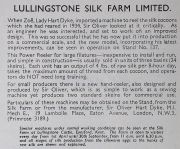Lullingstone Silk Farm
of Lullingstone Castle, Eynsford, Kent. Telephone: Farningham 14. Cables: "Hartdyke, Eynsford, Kent". (1947)
The house remained in the same family for six-hundred years. It was empty when Sir Oliver Hart Dyke married Zoe, who became Lady Hart Dyke and who started the famous Lullingstone silk farm in part of the house.
1937 Silk from the farm was used for Queen Elizabeth's Coronation robes in 1937, as well as for dresses for the two princesses, Elizabeth and Margaret Rose.
Later, more Lullingstone silk was incorporated in Princess Elizabeth's wedding dress, and during World War II it went to make parachutes.
1947 Advert for Silk Farm. "When Zoë, Lady Hart dyke, imported a machine to reel the silk cocoon which she had reared in 1934, Sir Oliver looked at it critically. As an engineer he was interested, and set to work on an improved design. This was so successful that he has now put it into production on a commercial scale, and the new model, incorporating his latest improvements, can be seen in operation on Stand No. 137. This Power Reeler for large filatures - inexpensive to install and run, and simple in construction - is usually sold in units of three basins (24 skeins). Each unit has an output of 4lbs of raw silk per 8-hour day, takes the maximum amount of thread from each cocoon, and operators do NOT need long training. For small producers there is a new hand-reeler, also designed and produced by Sir Oliver, which is as simple to work as a sewing machine yet produces two standard skeins for commercial use. Particulars of these machines may be obtained on the Stand, from the Silk Farm or from the manufacturer, Sir Oliver Hart Dyke, M.I. Mech E., Lambolle Place, Eaton Avenue, London, NW3. (Primrose 3189)."
Manufacturers of Power and Hand Silk Reeling Machines and Producers of Raw Silk. (Textiles Section - Earls Court, Ground Floor, Stand No.37) [1]
The whole enterprise has since moved to Compton House in Dorset, and it was from there that the silk used for the wedding dress of Princess Diana was spun.
See Also
- [1] The Village of Eynsford web page
Sources of Information
- ↑ 1947 British Industries Fair Advert 446; and p173


